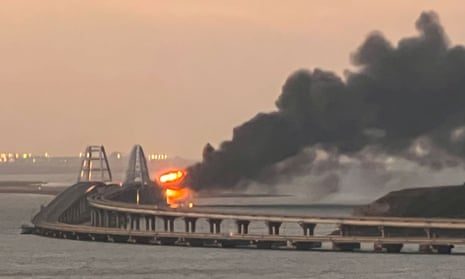The Kerch bridge from Russia to Crimea, a hated symbol of the Kremlin’s occupation of the southern Ukrainian peninsular and one of Vladimir Putin’s prestige projects, has been hit by a massive explosion.
Images from the bridge showed a fiercely burning fire engulfing at least two railway carriages from a train on the bridge, accompanied by a vast column of black smoke, and one half of the parallel road bridge collapsed into the Kerch Strait.
The explosion, which witnesses said could be heard kilometres away, took place before 6am on Saturday while a train was crossing the bridge.
It was not immediately clear what caused it, however Mykhailo Podolyak, an adviser to the Ukrainian presidency, appeared to suggest Kyiv’s responsibility, tweeting: “Crimea, the bridge, the beginning. Everything illegal must be destroyed, everything stolen must be returned to Ukraine, everything belonging to the Russian occupation must be expelled.”
Damage to the road section of the bridge showed the carriageway appeared to have been cleanly severed with no obvious sign of a missile strike in the first images to emerge, leading some to suggest the attack on the bridge might have been a spectacular act of of sabotage.
Video footage being shared on Russian Telegram channels appeared to show a truck at the centre of the explosion but it was not clear whether the truck itself exploded or was caught in the blast.
The bridge is both highly symbolic to Russia and an important logistical supply route for Russian forces in Crimea and in southern Russian-occupied Ukraine. The damage to the railway line in particular leaves Russian forces in the south with a single railway supply line – between Krasnodar and Melitopol – and one now within range of Ukraine attacks.
The blast on the bridge came a day after Putin marked his 70th birthday and amid mounting criticism in Russia of the conduct of his war against Ukraine after a series of increasingly devastating setbacks on the battlefield in recent weeks.
In the immediate aftermath of the explosion reports emerged of residents in the Crimea rushing to petrol stations anxious about fuel shortages.
As in previous attacks in Crimea, official Russian sources were vague about the cause of the blast with the news service Tass saying a fuel tanker was involved. “According to preliminary data, a fuel tank [railroad] car has been on fire at one of the sections of the Crimean bridge, shipping arches aren’t damaged, said Oleg Kryuchkov, an adviser to the Russian occupation head of the Crimea.
Another Moscow-appointed official said: “A cistern carriage is burning with fuel on one of the bridge sections. Shipping arches aren’t affected. Too early to talk about reasons and consequences. Work is under way to put out the fire.”
However, video footage taken from the road span appeared to show fires burning fiercely in several railway trucks along the length of the train, with the train stationary on the bridge.
Purported video footage from the moment of the explosion also seemed to strongly suggest a deliberate attack with high explosives.
Commenting on the attack in a thread on Twitter, analysts and retired Australian general Mick Ryan said: “First dropping a bridge span like this would take a lot of ‘bang’ (explosives) and good demolition design. As a sapper, we plan these kind of things all the time. The hardest bridges to drop are reinforced concrete like this.
“The amount of explosive required would be more than a few SF personnel could carry. A few trucks, or missiles / bombs would do the trick, if aimed at the right points of the bridge span.
“Either way, it presents the Russians with a significant problem. It doesn’t stop resupply to Crimea (there are boats and the route through Melitopol), but it makes holding Melitopol even more important for the Russians.”

Some 12 miles (19km) long, the road bridge was opened by Putin in 2018, with the railway bridge opening two years later.
During the nine-month war in Ukraine, Russia had for months assumed that Crimea – including the Kerch bridge – was beyond the ability of Ukrainian forces to strike. However in the past two months a series of explosions have hit sites in the Crimea including the Saky naval air base, amid mounting confidence in Kyiv that it can retake Crimea.
The fire occurred hours after explosions rocked the eastern Ukrainian city of Kharkiv early Saturday, sending towering plumes of smoke into the sky and triggering a series of secondary explosions.
Kharkiv mayor Ihor Terekhov said on Telegram that the early-morning explosions were the result of missile strikes in the centre of the city. He said the blasts sparked fires at one of the city’s medical institutions and a non-residential building. There were no immediate reports of casualties.
